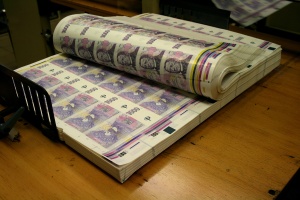Hat Trick Letter – říjen, 2.část

Minulý týden jsem publikoval první část výňatku zaměřenou na operaci Twist, stav eurozóny a pohled na bankovnictví.
Potenciální snížení ratingu Francie
MOODYS SET THE STAGE TO DOWNGRADE FRENCH GOVT DEBT, AS THEY DESCRIBED THEIR POSITION AS NO BETTER THAN P.I.G.S. NATIONS. FRANCEHAS THE BIGGEST EXPOSURE TO SOUTHERN EUROPE DEBT ON SOVEREIGN BONDS. THEIR FINANCIAL STRUCTURE IS WEAKENING BADLY, THE OBJECT OF SCRUTINY BY MOODYS. EVEN DEUTSCHE BANK EXPECTS FRANCE TO BE DOWNGRADED SOON, OR BE ON TRACK TO DOWNGRADE. THE EFFECT ON GERMAN AND SWISS BANKS WOULD BE DIRECT AND STRONG.
Moodys has declared the French Govt debt to be the weakest of all the Aaa-rated nations. It came as unwelcome news going into the G-20 summit, whose finance ministers gave an ultimatum to make progress on its sovereign debt crisis. Deutsche Bank expects the rating agencies to eventually put France on downgrade review. Moodys announced that the financial position of the official French debt has suffered a deterioration. They plan to monitor and assess any potential adverse economic or financial market developments, which means watch the economy, bond market, and bank stocks. It was an update, rather than a ratings action. While Moodys believes the large diversified economy with a history of innovation and sizeable savings can absorb shocks, they note the government financial strength has weakened, like with other EuroZone sovereigns, as the global financial and economic crisis tumbles along. France has been labeled the weakest of their Aaa peers. They remain comfortable with the cost of debt, namely the bond yield. France could face further challenges from banks exposed to other European sovereigns or to its own banking system. The French banks are the biggest creditor to the PIGS nations, the largest exposure. The deterioration in debt metrics and the potential for further liabilities to emerge are exerting pressure on the stable outlook of their Aaa debt rating. Their balance sheet has no room to maneuver on any expansion.
Deutsche Bank warned that France could be placed on downgrade review before January. Earlier, Credit Suisse estimated 66 European banks will fail the next stress test, which might not be so shoddy a test. They will require hundreds of $billions in fresh capital. DBank wrote, „We highlight in this note that the French corporate sector is already financially stretched, with poor profitability and large borrowing requirements. We consider that the deterioration in economic conditions is now creating a distinct risk that France could be put under Negative Watch by the rating agencies before the end of this year. We think that Francehas the wherewithal to react to such an outcome and could avoid an outright downgrade by taking corrective measures quickly, but this naturally would be a very sensitive political decision a few months before a major election.“ Some analysts wonder aloud why Credit Suisse and Deutsche Bank would jeopardize declines in their own balance sheets with such comments, since exposed to risks they point out. Neither bank can survive a vigilante attack on French spreads, as the shift in contagion would move directly to Germany.
Snížení ratingu Španělska
SPANISH GOVT DEBT WAS GIVEN A RATINGS CUT BY MOODYS AND FITCH. THEY CITED ECONOMIC RISK, BANKING SYSTEM DETERIORATION, LIMITED CREDIT FACILITY ACCESS, LOWER TAX REVENUE, AND DRAINED CASH RESERVES. THE POOR PROSPECT OF SOVEREIGN DEBT SOLUTIONS AGGRAVATES THE ENTIRE PICTURE.
Moodys delivered a nasty blow to Spain, as they gave a double downgrade, two notches down to A1 with a negative outlook as well. No credible resolution of the sovereign debt crisis has been offered or has come with economic developments. Moodys pointed to a potential further escalation of the EuroZone debt crisis. The rating agency expects that the makeup of the next parliament after the November 20th elections will be strongly committed to continued fiscal consolidation. Another debt downgrade would come if the new makeup was not so committed. Any decisive credible fiscal and structural reform plan would provide aid to a stable outlook. Long-term economic strength in Spain is no longer considered to be viable, as the lengthy economic rebalancing process unfolds. Moodys noted that most sovereign issuers with a Aa3 rating have much stronger fiscal and external positions than Spain, such as very low public debt, sound public finances, and a net creditor status. Hence, Spain is considered more vulnerable to a funding crisis from vanishing confidence. Standard & Poors slapped Spain with its third rating cut in three years, down one level to AA-, the fourth highest investment grade. It cited slowing growth and rising defaults that threaten banks and undermine efforts to contain the EuroZone sovereign debt crisis. They kept the negative outlook, expecting their banking system to weaken further and balance sheet of impaired assets to grow.
Moodys reiterated the undeserved French Aaa rating, even gave them an undeserved stable outlook. The debt ratings agency downgraded nine Spanish regions, two Basque provinces, and five government related entities, only one day after it downgraded Spanish sovereign debt, in a massacre. It downgraded the Castilla La Mancha by five notches, from A3 to Ba2. The Man of LaMancha (Zero Mostel) must be angry. The gravity of the debt crisis has deepend in Spain, which along with Italy remain highly vulnerable to banking contagion. One must wonder if the US financial forces are piling on, working in unison with a mission, so the USDollar is lifted. Perhaps ten big US banks also deserve steady ratchets of downgrades.
The rating actions concluded the review for possible downgrade initiated for eight ratings on 29 July 2011. Some details. The Spanish Govt debt went to A1 from Aa2 with a negative outlook. Moodys cited growing liquidity pressures and large financing needs with constrained access to long-term funding sources, depleted cash reserves, extensive usage of short-term credit lines, and expanded commercial debt obligations. They stressed persistent fiscal imbalances and lower expected tax revenue, as the Deficit/GDP ratio rose to 1.2% in the first six months of 2011.
Snížení ratingu Itálie a italských bank
MOODYS SLAMMED ITALIAN GOVT DEBT WITH A GIANT TRIPLE DOWNGRADE. THEIR ACTION CAME WITH A COMPREHENSIVE CRITIQUE THAT LEFT NO DOUBT ON THE DETERIORATING CONDITION. THEY CITED RISK OF BEING LOCKED OUT OF THE BOND YIELD FOR FUNDING, A DIFFICULT POLITICAL CLIMATE TO MAKE AGREEMENTS, AND ENGRAINED INEFFICIENCIES.
Moodys gave a huge nasty triple downgrades to Italian Govt debt, from Aa2 to A2, and lowered the outlook to negative. The main drivers that prompted the rating downgrade were higher funding risks with higher levels of public debt and higher bond yields paid out, increased downside risks to the economy due to macroeconomic structural weaknesses, and risks to the implementation of budget cuts. Another loud comprehensive slam. They were kind in soft words, since the Italian Govt and prime minister have been defiant in spending cuts. The leader Berlusconi once said this summer that big budget cuts were not to come, since if he wanted to preside over a field of shit, he would run a farm. Moodys pointed to continued significant imbalances in the economy and severe pressure on private financial and non-financial sector balance sheets. The Italian financial system remains vulnerable to financial shocks, as a result of a structural shift in market sentiment regarding EuroZone countries with high debt burdens. In other words, Italian Govt bond yields have risen. Concern was expressed for the country’s access to the public debt markets. If locked out of external sources of liquidity, the debt rating could be put substantially lower.
Moodys gave details on the related drivers to their downgrade decision. High debt levels put at risk the finance costs and funding risks. Italy has refinancing needs of more than EUR 200 billion in 2012. As indicated by the A2 rating, the risk of default by Italy remains remote. However, the structural shift in sentiment in the EuroZone funding market implies increased vulnerability, as in high bond yield or being locked out. The Italian Economy continues to suffer from structural weaknesses such as low productivity alongside rigidities in the labor and product market. The problems have dogged the nation for a full decade. The structural impediments are only recently being discussed and addressed. The Italian Govt seems intractible in achieving fiscal targets, meaning budget cuts. Even a mild economic downturn would adversely hit the budget and bring much larger deficits. Political consensus on additional expenditure cuts can be difficult in this highly charged emotional nation. Moodys expects the Italian public Debt/GDP ratio to reach 120% by yearend.
STANDARD & POORS DOWNGRADED 20 ITALIAN BANKS, AS THEIR BANKING SYSTEM WAS DECLARED UNFIXABLE. IT WAS A LOUD SLAM, A NASTY TABLE POUNDING EVENT HEARD CLEARLY. S&P GAVE STRONG INDICATION THAT THEY EXPECT ITALIAN BANKS TO RECEIVE A HUGE CAPITAL BOOST, MEANING SOME NEAR DEATH EVENTS FROM FAILURES
Standard & Poors downgraded a slew of more than 20 Italian banks, calling the climate difficult and describing the future prospect as neither transitory nor easily reversed. Italyhas been spared much attention until the last few weeks. They left no doubt on a dim negative outlook. To sure to know that Italy is the next PIGS shoe to drop. It seems that on each day, yet another debt downgrade comes to the Southern Europe group of wrecks that increasingly includesFrance. The official S&P statement read, „In our opinion, renewed market tensions in the EuroZone periphery, particularly in Italy, and dimming growth prospects have led to further deterioration in the operating environment for Italian banks. The cost of funding for Italian banks will increase noticeably because of higher yields on Italian sovereign debt. Furthermore, we expect the higher funding costs for both banks and corporate bonds to result in tighter credit conditions and weaker economic activity in the short-to-medium term.We do not believe that this difficult operating climate is transitory or that it will be easily reversed. In our view, funding costs for Italian banks and corporates will remain noticeably higher than those in other EuroZone countries, unless the Italian government implements workable growth enhancing measures and achieves a faster reduction in the public sector debt burden. Consequently, we envisage a situation where the Italian banks may well be operating with a competitive disadvantage versus their peers in other EuroZone countries. At the same time, we think all banking systems across the EuroZone, including Italy, may raise their commitment to reinforcing bank capitalization.“ They expect a big aid package to come to Italian banks, which is a nice way of seeing some near death failure events forcing the capitalization process.
Co na to evropské banky
SOME LARGE EUROPEAN BANKS WILL PROCEED WITH LIQUIDATIONS, AND NOT RAISE CAPITAL IN THE CURRENT LOW VALUE ENVIRONMENT. FRUSTRATION HAS GROWN OVER THE BAILOUT FUND, THE REQUIRED INFUSIONS, BANK CAPITAL REQUIREMENTS, AND NECESSARY STEPS TO RECAPITALIZE. SOME BANKS ARE QUITTING AND HAVE DECIDED TO SELL ASSETS. THEY TOO WILL BRING LOW VALUES. TWO GIANT FRENCH BANKS LEAD THE PROCESS. LOOK FOR IMPAIRED US-MORTGAGE BONDS TO BE IN THEIR PORTFOLIOS, LED BY THE PRIME-X BONDS THAT FELL HARD.
Some big European banks ddmit they have refused to raise capital in the current environment. They will proceed with asset liquidations instead. The Financial Times confirms the development. But the price of sales will be depressed, just like the bank stock shares for secondary sales. The European banks have balked at the prospect of recapitalizing at current levels, not wanting to raise capital at these depressed share price levels. The average European bank equity is trading at only 60% of its book value. The banks have made commitments behind closed door and instead will opt for asset liquidations. The big banks cringe at the thought of massive dilution from additional stock shares issued and sold. Meanwhile, the short-term funding markets appear to shut out banks for the fourth month in a row. They are stuck between a market rock and a balance sheet hard place. The key prerequisite to any recapitalization plans is absent. The higher capital needs are to fund ratio requirements per Basel III, a big thorn in their side. The ugly truth is that banks desperately need capital just to operate, apart from newly enforced Baselstrictures to hit in 2016. Expect a potential wave of liquidations, especially of US$-denominated assets. Watch to see who sells first, since they will sell at the best price. They own many assets in common, so a race out the door is coming.
The Financial Times reported on the radical approach, led by French banks BNP Paribas and Societe Generale. The two French giant banks have signalled plans to offload a combined EUR 150 billion of risk weighted assets. Other businesses could be sold. The troubled Unicredit from Italy and Commerzbank from Germany are seen as under the most pressure to deleverage and undergo divestiture of assets. Expect the approach to be copied by lenders acrossItaly, Spain, and Germany, the internal banker sources described. The shrinkage strategy will surely prove controversial with politicians and regulators when bankers lend less still to customers, tossinga major damper on the EuroZone economic recovery. Better stated, a damper on the EU Economy already in recession. EU Commission Barroso emerged from a disappointing session, in which no specifics on the EU bank recapitalization plan were offered, since none existed. Much talk had come on debate between the US and EU finance ministers over leverage used to replenish both the stability bailout fund and implicitly the bank rescues. The regulator body, the European Banking Authority, is prepared to set a higher bar than expected at a 9% ratio of core Tier-1 capital to assets for banks across the continent. A deadline of six to nine months would be set for forceable recapitalization by governments, unless the banks completed the process on their own volition. Investors are extremely unwilling to commit to fresh equity injections, knowing the new money would be soaked up by sovereign debt writedowns. This is a very important point. Rescues go down a black hole!! Such is the nature of collapsed Ponzi schemes, as is the entire Western economy, built upon debt and derivatives. The public might be treated to more stress tests. Some analysts expect them to contain some actual stress, but it is unlikely. Watch for European banks to mention commercial mortgage bonds and Prime-X assets, the prime mortgage bonds whose values are diving down.
________________________________________
Na základě souhlasu Jima Willieho budu zde pravidelně publikovat výňatky z jeho Hat Trick Reportu, jehož jsem předplatitelem. Výňatky budou publikovány formou citátů. Vybírat budu takové informace, které nejsou běžně dostupné. Formátování textu (tučné, podtržené, kurzíva, velká písmena) je původní.
Více informací na goldenjackass.com
I subscribe to Hat Trick Report and gained permission to publish extracts on my web. Formatting of text (caps lock, bold…) is same as in original report. I pick up information not available on main stream media.
For more information: goldenjackass.com
Upozorňuji čtenáře, že svolení Jima Willie se týká publikování pouze na webu www.proinvestory.cz. Kopírováním obsahu z těchto stránek by se ten, kdo kopíruje názor Jima Willie bez jeho svolení, dopustil porušení ochrany autorských práv Jima Willie.



